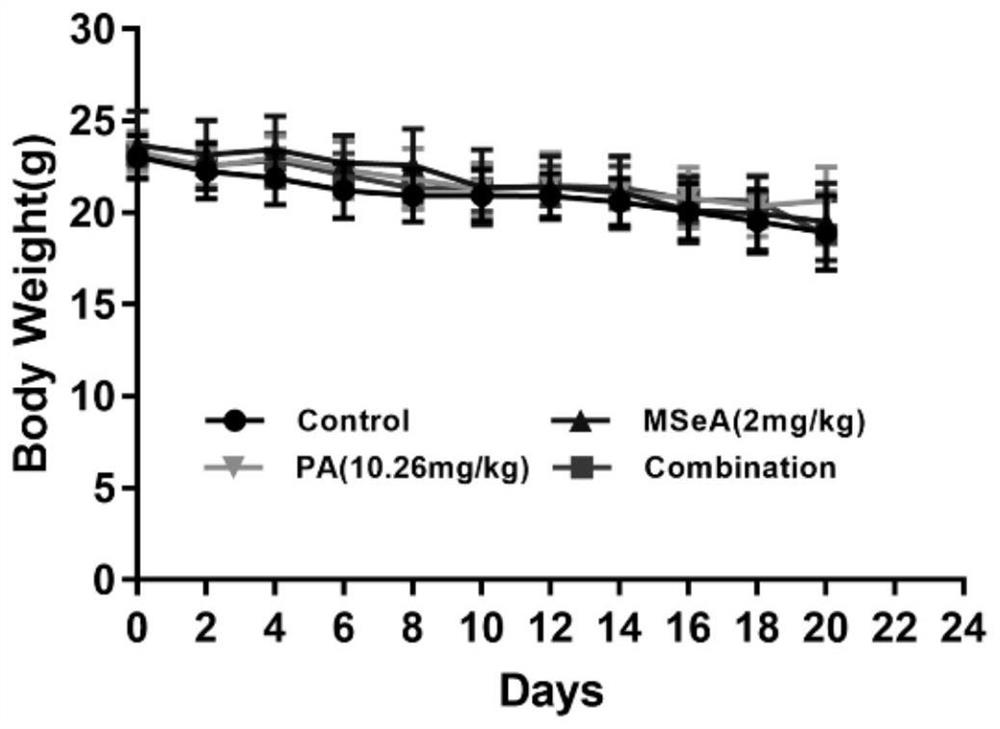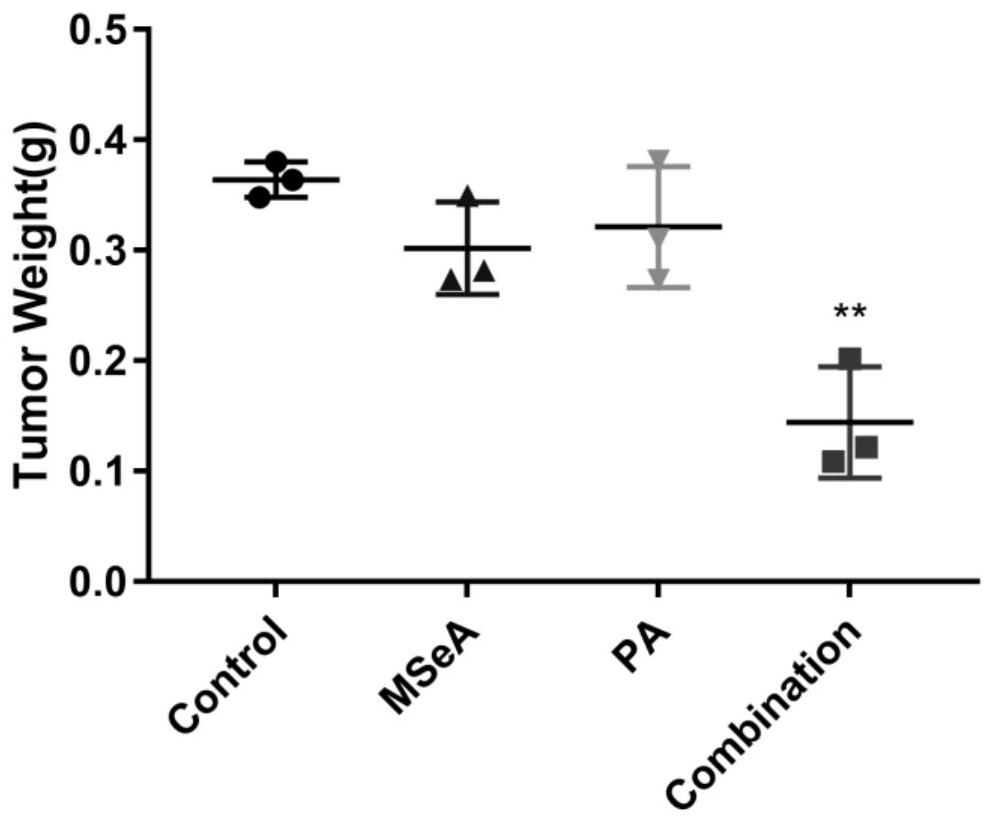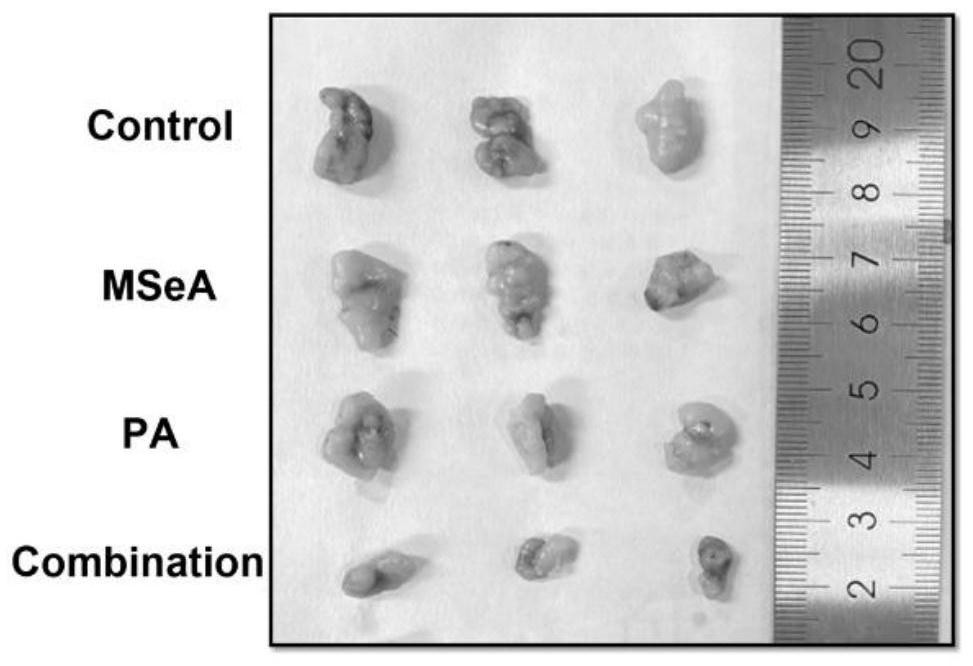New application of palmitic acid as anti-hepatocarcinoma sensitizer of methylselenic acid
A technology of methyl selenic acid and palmitic acid, which is applied in the field of medicine, can solve the problems of synergism, and achieve the effect of anti-liver cancer treatment synergy, enhanced induction of liver cancer cell apoptosis, and good effect of lipotoxicity
- Summary
- Abstract
- Description
- Claims
- Application Information
AI Technical Summary
Problems solved by technology
Method used
Image
Examples
Embodiment 1
[0024] Example 1. The effect of palmitic acid on increasing the anti-liver cancer efficacy of methylselenic acid in mice.
[0025] Test method: 12 male BALB / C nude mice (Beijing Weitong Lihua Experimental Technology Co., Ltd.), 6-8 weeks old, 2 × 10 6 A HepG2 cell was mixed with an equal volume of Matrigel, injected subcutaneously into the right side of the mouse, and the tumor volume was measured with a vernier caliper. When the tumor volume is about 100-120mm 3 , the mice were randomly divided into control group, methyl selenic acid treatment group, palmitic acid treatment group and combined treatment group. The corresponding solvent was administered to the control group, the methyl selenic acid treatment group was intragastrically administered at a dose of 2 mg / kg per day, and the palmitic acid treatment group was intragastrically administered at a daily dose of 10.26 mg / kg. Mouse body weight and tumor volume were measured every other day. After the end of the experiment...
Embodiment 2
[0028] Embodiment 2, palmitic acid increases the apoptosis of HepG2 human liver cancer cells induced by methyl selenic acid
[0029] Human liver cancer cell line HepG2 cells were treated with MSeA at a low dose concentration of 2 μM for 24 hours, then 100 μM or 200 μM PA was added, and the number of apoptotic cells was detected by Annexin V-FITC / PI double staining method. Figure 4 The results showed that the number of cells treated with 2μMMSeA was not significantly different from that of the control group, the addition of PA induced the apoptosis of HepG2 cells, and the combined treatment group significantly caused cell death. The results showed that palmitic acid could increase the apoptosis of HepG2 human hepatoma cells induced by methylselenoic acid.
Embodiment 3
[0030] Example 3, methyl selenic acid prevents lipapoptosis of L02 human normal liver cells caused by palmitic acid
[0031] Using palmitic acid-treated L02 normal human liver cells as a model, the number of apoptotic cells was detected by crystal violet. After pretreatment of L02 cells with 2 μM MSeA for 24 h, corresponding concentrations of palmitic acid were added. Figure 5 The results shown indicated that the addition of MSeA significantly restored cell viability. The results showed that methyl selenic acid could prevent the apoptosis of L02 human normal liver cells induced by palmitic acid.
PUM
 Login to View More
Login to View More Abstract
Description
Claims
Application Information
 Login to View More
Login to View More - R&D
- Intellectual Property
- Life Sciences
- Materials
- Tech Scout
- Unparalleled Data Quality
- Higher Quality Content
- 60% Fewer Hallucinations
Browse by: Latest US Patents, China's latest patents, Technical Efficacy Thesaurus, Application Domain, Technology Topic, Popular Technical Reports.
© 2025 PatSnap. All rights reserved.Legal|Privacy policy|Modern Slavery Act Transparency Statement|Sitemap|About US| Contact US: help@patsnap.com



